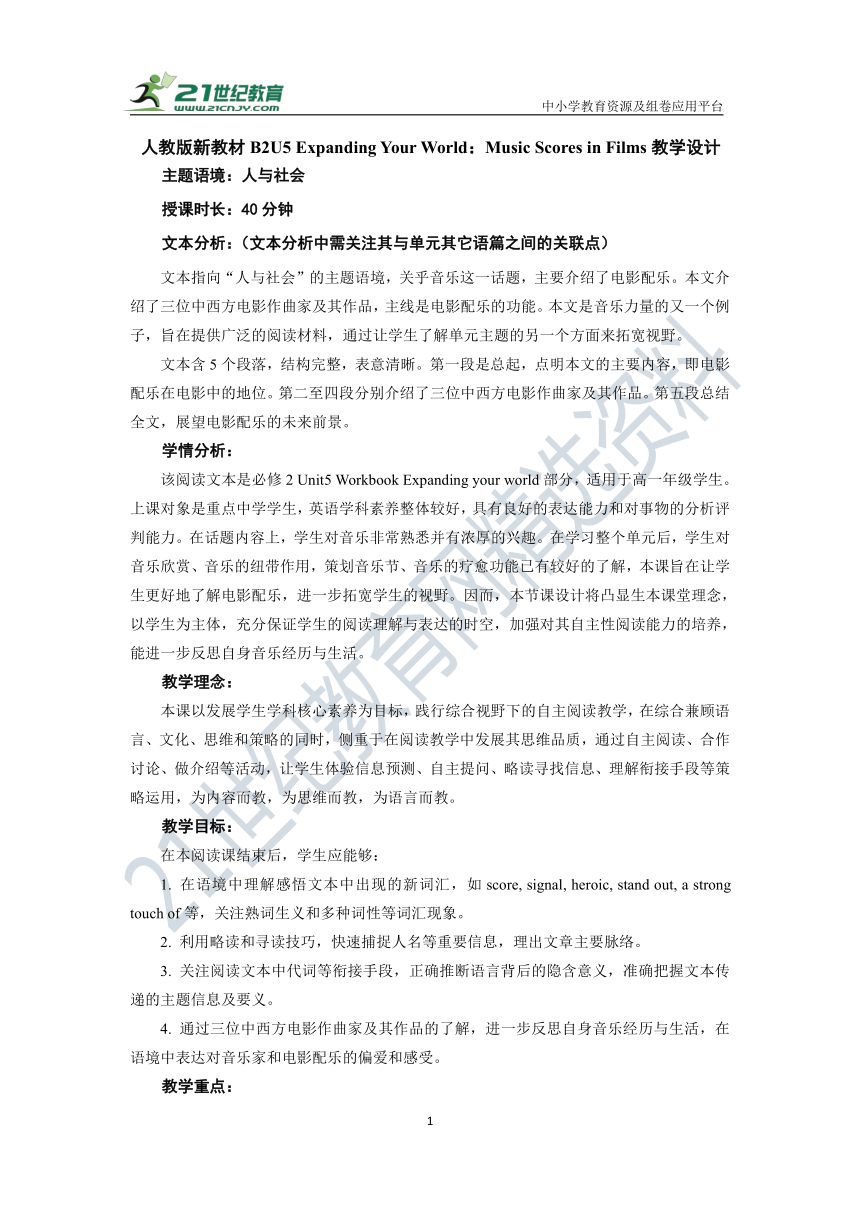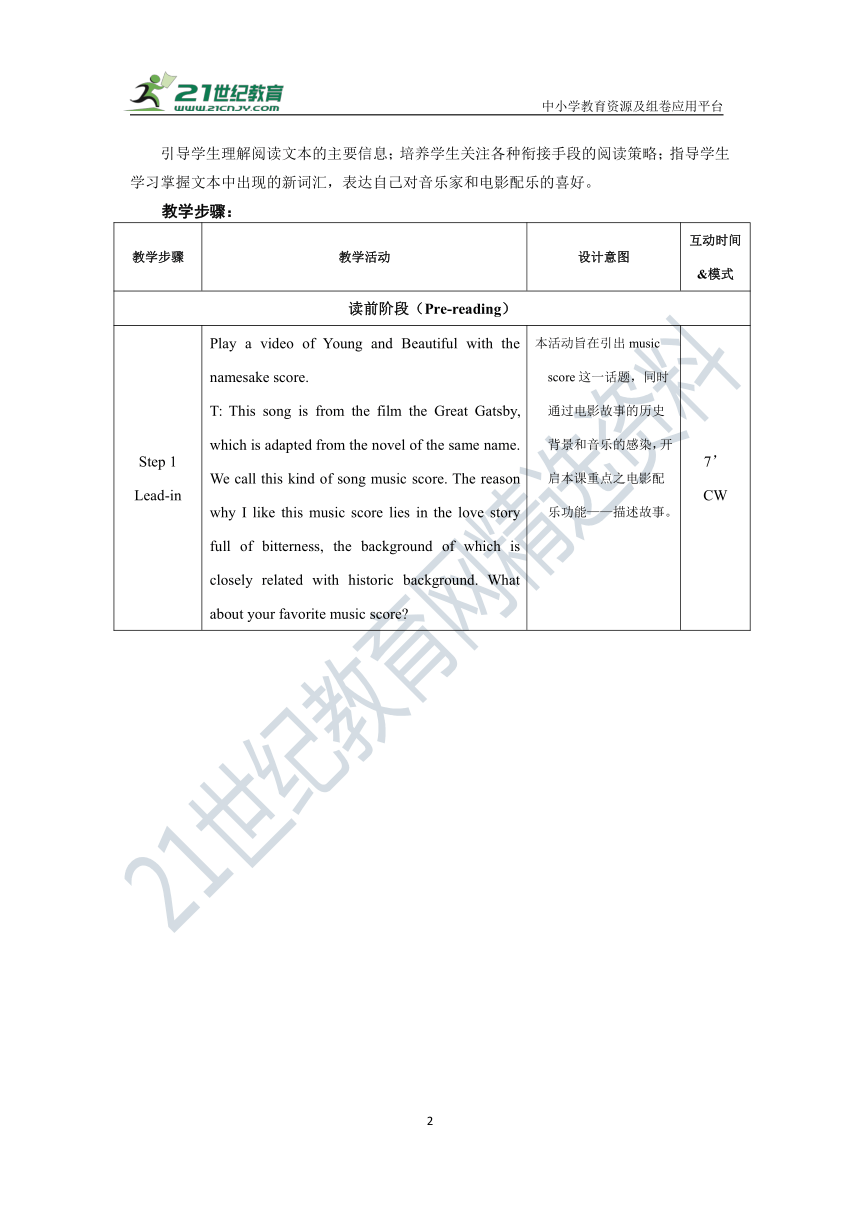人教版(2019)必修第二册 Unit 5 Music Expanding your world 教学设计
文档属性
| 名称 | 人教版(2019)必修第二册 Unit 5 Music Expanding your world 教学设计 |

|
|
| 格式 | docx | ||
| 文件大小 | 141.2KB | ||
| 资源类型 | 试卷 | ||
| 版本资源 | 人教版(2019) | ||
| 科目 | 英语 | ||
| 更新时间 | 2024-09-21 14:34:33 | ||
图片预览


文档简介
中小学教育资源及组卷应用平台
人教版新教材B2U5 Expanding Your World:Music Scores in Films教学设计
主题语境:人与社会
授课时长:40分钟
文本分析:(文本分析中需关注其与单元其它语篇之间的关联点)
文本指向“人与社会”的主题语境,关乎音乐这一话题,主要介绍了电影配乐。本文介绍了三位中西方电影作曲家及其作品,主线是电影配乐的功能。本文是音乐力量的又一个例子,旨在提供广泛的阅读材料,通过让学生了解单元主题的另一个方面来拓宽视野。
文本含5个段落,结构完整,表意清晰。第一段是总起,点明本文的主要内容,即电影配乐在电影中的地位。第二至四段分别介绍了三位中西方电影作曲家及其作品。第五段总结全文,展望电影配乐的未来前景。
学情分析:
该阅读文本是必修2 Unit5 Workbook Expanding your world部分,适用于高一年级学生。上课对象是重点中学学生,英语学科素养整体较好,具有良好的表达能力和对事物的分析评判能力。在话题内容上,学生对音乐非常熟悉并有浓厚的兴趣。在学习整个单元后,学生对音乐欣赏、音乐的纽带作用,策划音乐节、音乐的疗愈功能已有较好的了解,本课旨在让学生更好地了解电影配乐,进一步拓宽学生的视野。因而,本节课设计将凸显生本课堂理念,以学生为主体,充分保证学生的阅读理解与表达的时空,加强对其自主性阅读能力的培养,能进一步反思自身音乐经历与生活。
教学理念:
本课以发展学生学科核心素养为目标,践行综合视野下的自主阅读教学,在综合兼顾语言、文化、思维和策略的同时,侧重于在阅读教学中发展其思维品质,通过自主阅读、合作讨论、做介绍等活动,让学生体验信息预测、自主提问、略读寻找信息、理解衔接手段等策略运用,为内容而教,为思维而教,为语言而教。
教学目标:
在本阅读课结束后,学生应能够:
1. 在语境中理解感悟文本中出现的新词汇,如score, signal, heroic, stand out, a strong touch of等,关注熟词生义和多种词性等词汇现象。
2. 利用略读和寻读技巧,快速捕捉人名等重要信息,理出文章主要脉络。
3. 关注阅读文本中代词等衔接手段,正确推断语言背后的隐含意义,准确把握文本传递的主题信息及要义。
4. 通过三位中西方电影作曲家及其作品的了解,进一步反思自身音乐经历与生活,在语境中表达对音乐家和电影配乐的偏爱和感受。
教学重点:
引导学生理解阅读文本的主要信息;培养学生关注各种衔接手段的阅读策略;指导学生学习掌握文本中出现的新词汇,表达自己对音乐家和电影配乐的喜好。
教学步骤:
教学步骤 教学活动 设计意图 互动时间&模式
读前阶段(Pre-reading)
Step 1 Lead-in Play a video of Young and Beautiful with the namesake score. T: This song is from the film the Great Gatsby, which is adapted from the novel of the same name. We call this kind of song music score. The reason why I like this music score lies in the love story full of bitterness, the background of which is closely related with historic background. What about your favorite music score 本活动旨在引出music score这一话题,同时通过电影故事的历史背景和音乐的感染,开启本课重点之电影配乐功能——描述故事。 7’ CW
Step 2 Prediction Look at the title and the picture and predict what will be talked about in the text. Q1: What is a music score Q2: What is the function of a music score Q3: How is a music score created Q4: How do music scores develop 通过观察教材插图和标题自主提问,启动主题思维,引导学生初步感知、注意文本的话题内容,形成阅读期待。 3’ CW IW
读时阶段(While-reading)
Step 3 Global reading (skimming) Ss read the text briefly to check their prediction. Meanwhile, try to conclude the main idea. Ss are guided to pay attention to the cohesive devices the writer uses to connect the three film composers, such as “No one can talk about...without talking about...”. T: How can you quickly find all the three film composers 该活动旨在训练学生快速阅读全文以获取主要信息(Skimming for main idea)的阅读策略,并解决自主提问。同时,训练学生关注衔接手段,快速梳理文章结构的能力。 5’ IW
Step 4 Detailed reading Ss read the passage to draw a mindmap about three film composers. After finishing it, they choose the one they prefer and give an introduction. After Ss finish presenting, T asks more questions to promote their further understanding. Questions are as follows: Q1: In para. 2, how many examples are used How do you know Q2: In para. 2, what are you meant to think according to the third sentence Q3: In para. 3, how do you understand “that is not the point” Q4: What is the function of music scores Q5: In what way is Tan Dun different from other film composers Q6: What kind of emotions can you get from the audio (After Ss listen to an audio from Hidden Dragon.) 该活动1通过信息的获取梳理与解读,培养学生自主加工信息的能力,并能在教师的追问下加深理解,如关注代词,通过上下文猜测词义等。信息梳理完成后,鼓励学生发散思维,在感受音乐魅力的同时,达成本单元语言目标,即表达对音乐的偏爱和感受。 18’ CW IW GW
读后阶段(Post-reading)
Step 5 Critical thinking Ss read the last paragraph and think about what the word “this” refers to. Then, Ss are invited to think critically about whether film scores should be considered high art and why. 通过批判性思考,加强学生面对新问题整合和运用分析和解决问题的能力。 7’ IW GW
备注:Ss: Students IW: Individual work GW: Group work CW: Class work
板书设计:
Music Scores in Films
(
score:
*There are scores of modern art styles.
*He just scored a goal.
*music scores
signal, heroic, stand out, a strong touch of
)Q1: What is a music score
Q2: What is the function of a music score
Q3: How is a music score created
Q4: How do music scores develop
7
人教版新教材B2U5 Expanding Your World:Music Scores in Films教学设计
主题语境:人与社会
授课时长:40分钟
文本分析:(文本分析中需关注其与单元其它语篇之间的关联点)
文本指向“人与社会”的主题语境,关乎音乐这一话题,主要介绍了电影配乐。本文介绍了三位中西方电影作曲家及其作品,主线是电影配乐的功能。本文是音乐力量的又一个例子,旨在提供广泛的阅读材料,通过让学生了解单元主题的另一个方面来拓宽视野。
文本含5个段落,结构完整,表意清晰。第一段是总起,点明本文的主要内容,即电影配乐在电影中的地位。第二至四段分别介绍了三位中西方电影作曲家及其作品。第五段总结全文,展望电影配乐的未来前景。
学情分析:
该阅读文本是必修2 Unit5 Workbook Expanding your world部分,适用于高一年级学生。上课对象是重点中学学生,英语学科素养整体较好,具有良好的表达能力和对事物的分析评判能力。在话题内容上,学生对音乐非常熟悉并有浓厚的兴趣。在学习整个单元后,学生对音乐欣赏、音乐的纽带作用,策划音乐节、音乐的疗愈功能已有较好的了解,本课旨在让学生更好地了解电影配乐,进一步拓宽学生的视野。因而,本节课设计将凸显生本课堂理念,以学生为主体,充分保证学生的阅读理解与表达的时空,加强对其自主性阅读能力的培养,能进一步反思自身音乐经历与生活。
教学理念:
本课以发展学生学科核心素养为目标,践行综合视野下的自主阅读教学,在综合兼顾语言、文化、思维和策略的同时,侧重于在阅读教学中发展其思维品质,通过自主阅读、合作讨论、做介绍等活动,让学生体验信息预测、自主提问、略读寻找信息、理解衔接手段等策略运用,为内容而教,为思维而教,为语言而教。
教学目标:
在本阅读课结束后,学生应能够:
1. 在语境中理解感悟文本中出现的新词汇,如score, signal, heroic, stand out, a strong touch of等,关注熟词生义和多种词性等词汇现象。
2. 利用略读和寻读技巧,快速捕捉人名等重要信息,理出文章主要脉络。
3. 关注阅读文本中代词等衔接手段,正确推断语言背后的隐含意义,准确把握文本传递的主题信息及要义。
4. 通过三位中西方电影作曲家及其作品的了解,进一步反思自身音乐经历与生活,在语境中表达对音乐家和电影配乐的偏爱和感受。
教学重点:
引导学生理解阅读文本的主要信息;培养学生关注各种衔接手段的阅读策略;指导学生学习掌握文本中出现的新词汇,表达自己对音乐家和电影配乐的喜好。
教学步骤:
教学步骤 教学活动 设计意图 互动时间&模式
读前阶段(Pre-reading)
Step 1 Lead-in Play a video of Young and Beautiful with the namesake score. T: This song is from the film the Great Gatsby, which is adapted from the novel of the same name. We call this kind of song music score. The reason why I like this music score lies in the love story full of bitterness, the background of which is closely related with historic background. What about your favorite music score 本活动旨在引出music score这一话题,同时通过电影故事的历史背景和音乐的感染,开启本课重点之电影配乐功能——描述故事。 7’ CW
Step 2 Prediction Look at the title and the picture and predict what will be talked about in the text. Q1: What is a music score Q2: What is the function of a music score Q3: How is a music score created Q4: How do music scores develop 通过观察教材插图和标题自主提问,启动主题思维,引导学生初步感知、注意文本的话题内容,形成阅读期待。 3’ CW IW
读时阶段(While-reading)
Step 3 Global reading (skimming) Ss read the text briefly to check their prediction. Meanwhile, try to conclude the main idea. Ss are guided to pay attention to the cohesive devices the writer uses to connect the three film composers, such as “No one can talk about...without talking about...”. T: How can you quickly find all the three film composers 该活动旨在训练学生快速阅读全文以获取主要信息(Skimming for main idea)的阅读策略,并解决自主提问。同时,训练学生关注衔接手段,快速梳理文章结构的能力。 5’ IW
Step 4 Detailed reading Ss read the passage to draw a mindmap about three film composers. After finishing it, they choose the one they prefer and give an introduction. After Ss finish presenting, T asks more questions to promote their further understanding. Questions are as follows: Q1: In para. 2, how many examples are used How do you know Q2: In para. 2, what are you meant to think according to the third sentence Q3: In para. 3, how do you understand “that is not the point” Q4: What is the function of music scores Q5: In what way is Tan Dun different from other film composers Q6: What kind of emotions can you get from the audio (After Ss listen to an audio from Hidden Dragon.) 该活动1通过信息的获取梳理与解读,培养学生自主加工信息的能力,并能在教师的追问下加深理解,如关注代词,通过上下文猜测词义等。信息梳理完成后,鼓励学生发散思维,在感受音乐魅力的同时,达成本单元语言目标,即表达对音乐的偏爱和感受。 18’ CW IW GW
读后阶段(Post-reading)
Step 5 Critical thinking Ss read the last paragraph and think about what the word “this” refers to. Then, Ss are invited to think critically about whether film scores should be considered high art and why. 通过批判性思考,加强学生面对新问题整合和运用分析和解决问题的能力。 7’ IW GW
备注:Ss: Students IW: Individual work GW: Group work CW: Class work
板书设计:
Music Scores in Films
(
score:
*There are scores of modern art styles.
*He just scored a goal.
*music scores
signal, heroic, stand out, a strong touch of
)Q1: What is a music score
Q2: What is the function of a music score
Q3: How is a music score created
Q4: How do music scores develop
7
